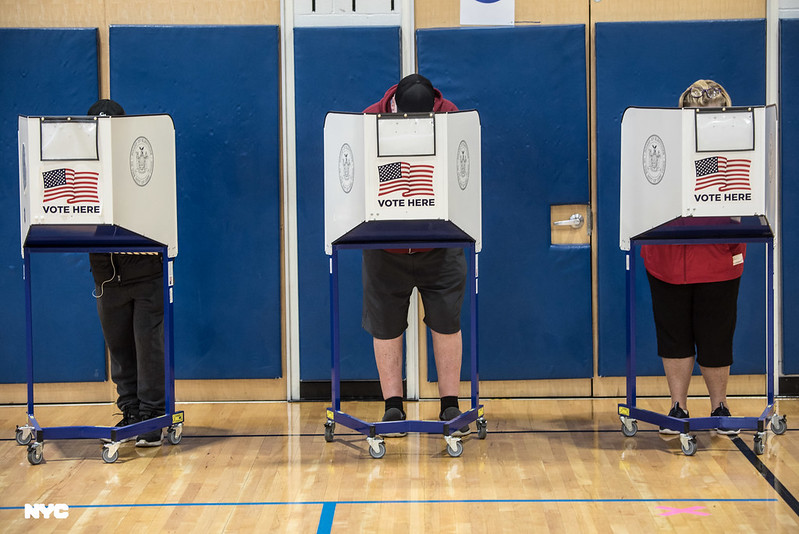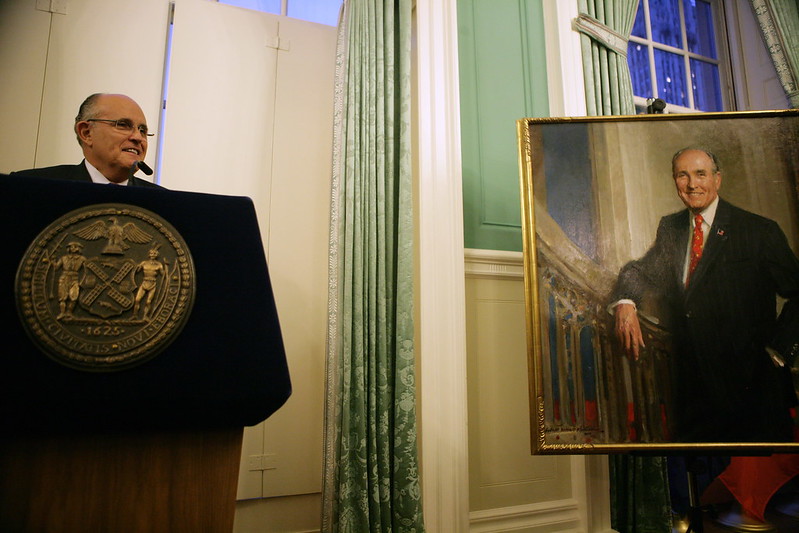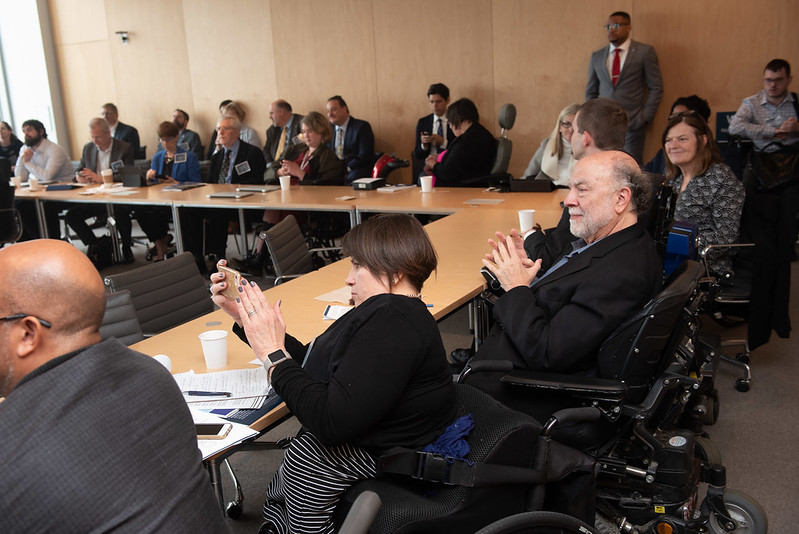Ranked-Choice Voting is Coming; NYC Must Immediately Fund a Public Education Campaign

Voters at work (photo: Michael Appleton/Mayoral Photography Office)
The combination of early voting, vote-by-mail, and the desire to vote out Donald Trump made 2020 a huge year for voting in New York City. Despite long lines, when voters are given the right resources and awareness, we can raise the level of participation.
As we turn towards 2021, the next chapter for voting in New York City will be the implementation of ranked-choice voting (RCV) for special and party primary elections for city government positions. If properly implemented, it will further improve our electoral process. But it’s an open question whether our government is up to the task of strong implementation, including extensive voter education, and the lack of effort and funding so far does not inspire confidence.
Ranked-choice voting allows voters to rank candidates based on their preferences, from choosing one up to five candidates in order. If a single candidate does not reach 50% of first-place votes, the last place candidate is eliminated and their votes are reallocated to the remaining candidates based on those voters’ second choices, with candidate elimination and vote reallocation continuing until a candidate hits 50%.
When properly implemented, ranked-choice voting is good for our democracy and our city:
It is a more accurate representation of the electorate and a fairer process.
It empowers voters to make more candidate preferences heard.
It forces campaigns to build broad coalitions -- to focus on winning over a majority of voters in their districts.
It decreases negative campaigning.
Ranked-choice voting will be a major change in how city officials are elected, yet most voters are unaware of what’s coming or how RCV will work. City government, having adopted this new system through a charter revision commission and voter referendum, has a responsibility to educate voters or risk disenfranchising large swaths of voters who are confused by the process. With the first ranked-choice election scheduled for a special election that will culminate on February 2 in Queens’ City Council District 24, a seat recently vacated by Rory Lancman, we cannot allow any more delays in launching a major public education campaign to ensure all voters understand ranked-choice voting.
After that special election, we will quickly have at least three more special City Council elections, followed by the June citywide primaries for Mayor, Comptroller, Public Advocate, Borough Presidents, and the entire City Council. With such a significant change in how voters will elect these officials, there is no time to waste.
Similar to the 2020 Census efforts, it is critical that the city immediately funds a public education campaign on ranked-choice voting. From sending mailings to voters, to partnering with local organizations and influencers to get the word out, to running television ads, to utilizing digital advertising, the city should be meeting voters where they are. Further, this outreach must be conducted in multiple languages so that voters for whom English is a second language are not left out of the civic process, as they too often are. We must be careful to include historically-disenfranchised communities of color in every part of our electoral process as we transition into ranked-choice elections.
Voting is the most sacred right in our country and a cornerstone of our democracy. With Republicans no longer able to block voting reforms in Albany, our laws are finally catching up with more progressive states and making voting easier. But failure to invest in civic education following such a major change creates an obstacle to reform, unintentionally suppressing votes. The implementation and funding of a ranked-choice voting education program is New York City’s opportunity to ensure the success of our new voting system, but only if we step up and take action right now.
***
Josué Pierre is a candidate for City Council in the 40th District, in Brooklyn. On Twitter @CitizenPierre.
***
Have an op-ed idea or submission for Gotham Gazette? Email This email address is being protected from spambots. You need JavaScript enabled to view it.
Rudy Giuliani Was Never Really ‘America’s Mayor’

Rudy Giuliani at City Hall (photo: Kristen Artz/mayor's office)
As Rudy Giuliani melts down – at times literally – in his desperate crusade to steal the election for his soundly defeated First Client, there has been much speculation about how “America’s Mayor” could have deteriorated into this spectacle.
Whatever may be going on with Rudy Giuliani personally, let’s be clear: while, for one brief moment in his career he served as a cheerleader for a devastated city and a shocked nation, the rest of Rudy Giuliani’s mayoralty was driven by a hostility to free expression, police brutality and violence, and an authoritarian disregard for democracy.
Let’s start with the First Amendment. The New York Civil Liberties Union was involved in 34 First Amendment lawsuits against the Giuliani administration – and prevailed in 26 of them. Those cases successfully challenged the firing of Police Officer Yvette Walton in retaliation for testifying before the City Council about racial profiling; the attempt to censor the Sensations exhibit at the Brooklyn Museum; the ban on press conferences and demonstrations by Giuliani critics on the steps of City Hall; the ban on condom distribution as part of AIDS education in City Parks; police harassment of homeless people sleeping on the steps of the Fifth Avenue Presbyterian Church; and singling out political demonstrators charged with minor offenses so that they could not get appearance tickets to return to court and often had to stay in jail overnight.
In the seven-and-a-half years before 9/11, let there be no mistake: racial bias, fear-mongering, and police brutality were the hallmarks of Giuliani’s mayoralty.
As mayor, Giuliani oversaw a policing regime repeatedly engaged in persecution and brutal assaults and killings of Black and Hispanic New Yorkers, using unlawful stop-and-frisk policies to jail Black and Hispanic New Yorkers in service of his ‘broken windows’ policing. Every time the NYPD killed a Black man, Rudy Giuliani was right there not only defending the police, but attacking the victim.
I will never forget his tirade against Patrick Dorismond, a 26-year-old Black security guard and father of two, after undercover police officers killed Dorismond after initiating a scuffle while on the job in Manhattan. Giuliani attacked Dorismond’s character and publicly revealed his legally-sealed juvenile record. It was Giuliani‘s notorious street crimes unit that killed Amadou Diallo in the lobby of his apartment building.
And in his second of three runs for mayor, his virulent support for the police union in its opposition to an independent Civilian Complaint Review Board (CCRB) that would hold officers accountable for abuse, culminated in a speech at the union’s off-duty rally steps from City Hall that ended in what can only be described as an rampage by our “men – yes men—in blue” so egregious that it pushed the City Council to establish the city’s independent CCRB.
Perhaps one of Giuliani’s most telling pre-Trumpian moments was his campaign to put cops in charge of discipline in New York City public schools. While violence in schools was actually declining in 1998, Giuliani withheld crime data from the Board of Education and convinced its members to replace the Board school safety unit with the NYPD’s school safety division. This eventually mushroomed into its own police force of over 5,000 officers who arrested and beat kids up for offenses like being in the school hallway without a pass or refusing to close a book in class.
Giuliani brought broken windows policing from the streets of Black and Hispanic communities into the public schools attended by Black and Hispanic children, launching the policies and practices that came to be known as the school-to-prison pipeline.
As the remnants of the World Trade Center smoldered, Giuliani, who was ineligible to run for another term, had been basking in the glow of public appreciation for his leadership. In that moment, in a troubling precursor to Trump’s threats to remain in office, he reportedly proposed that New York postpone the 2001 mayoral election and leave him in office, rather than allow New Yorkers to vote in the scheduled election and transition to a new mayor. Despite the fear and uncertainty that followed the horrific 9/11 attacks, New Yorkers weren’t fooled.
To be fair, there were two areas where Giuliani, as mayor, brought New York closer to our democratic values: immigrant rights and access to abortion care. But the defender of Trump’s Muslim ban and other xenophobic and discriminatory policies seems now to limit his love for the American melting pot to only those who look like him. And while he once supported abortion rights that too seems to have dissolved as he sinks deeper into the right-wing fever swamp.
We are not witnessing the deterioration of “America’s Mayor.” Today’s Giuliani is simply an extension of the authoritarian leader that New Yorkers have known all along.
***
Donna Lieberman is the Executive Director of the New York Civil Liberties, the state affiliate of the ACLU. On Twitter @JustAskDonna of @NYCLU.
***
Have an op-ed idea or submission for Gotham Gazette? Email This email address is being protected from spambots. You need JavaScript enabled to view it.
COVID-19 Sheds New Light on Innovations Long Championed by People with Disabilities

A pre-pandemic conference (photo: Michael Appleton/Mayoral Photography)
One of the great ironies of the new remote-working economy is that it is built on employment innovations that people with disabilities have long advocated. A second great irony is the speed with which those innovations – opposed by businesses for years – were adopted. These developments underscore, as we celebrate the 30th anniversary of the Americans with Disabilities Act this year, the importance of addressing the needs of people with disabilities and the potential for the broader public to benefit as a result.
COVID-19 taught the U.S. business community that it has a far greater ability to adapt to new ways of working than it realized. Within weeks of the pandemic’s arrival, the business community adjusted to numerous employment practices that were previously discouraged. With schools and offices closed, and parents working from home while trying to teach their children, companies faced a choice between adjusting or going out of business. Those that could adjust did.
Suddenly Zoom meetings became standard. Having children interrupt them was no problem. Flexible work hours were to be expected. Shifting meetings to meet family needs was fine, too.
Necessity may be the mother of invention. But what should not be missed is that such accommodations were long championed by people with disabilities, only to have been met with resistance. COVID-19 proved that not only were these changes manageable, but they were also improvements with widespread benefits.
People with disabilities led the way because they understood the challenge of work-life balance. A parent with Multiple Sclerosis knows the time-crunch of getting children ready for school, while needing extra time herself to get dressed and out the door. A person who uses a scooter knows the ordeal of getting from work to a doctor’s appointment and back again at mid-day. They understand that life cannot always fit the traditional nine-to-five business schedule.
Now that the entire workforce is benefiting, it is hard to believe we will ever return completely to the old ways, even when COVID-19 is behind us. Employers now know that parents can work from home effectively. They now know that a Zoom call can be just as valuable as an in-person meeting.
Telemedicine may be the best example of all. It had been available for years, yet government had constrained its growth by, among other things, not compensating health-care providers properly for its use. Now we are seeing telemedicine not only facilitate essential care effectively but bring that care to people who previously could not easily receive it.
Imagine the increased convenience, if you use a wheelchair, of having a medical check-up at home without going through the time, effort, and expense of getting to and from a doctor’s office, which may not even be wheelchair-accessible. The telemedicine check-up could save hours in connection with a 15-minute appointment. Now imagine having that same convenience if you live in a remote community – hours from the nearest medical facility.
It is vital to understand in this regard that “disability” is a social construct. A staircase makes someone in a wheelchair “disabled;” a ramp makes that person “abled.”
We need to move beyond the idea that people with disabilities are lacking something and recognize that they are adding something. We need to appreciate that the knowledge, experience, and perspective of people with disabilities offer benefits for everyone.
A key recognition is that flexibility in the workplace is an asset and should be embraced. With flexible tools such as videoconferencing now commonplace, the access that they provide should be exploited, too. For example, remote vocational training for people with disabilities – as for all people – makes it theoretically possible to expand educational opportunities to broader geographies. Yet compensation for training – typically provided through states – is often limited geographically, with contracts specifying service to New York City, for instance, as distinct from other parts of New York.
The U.S. workforce benefits when people with disabilities are included. The unemployment rate for people with disabilities was 2.5 times higher than the general population before COVID-19, and 70% were not in the workforce. It is time to make more adjustments to bring all people into the economic mainstream. It is time to recognize the contributions of people with disabilities to the newly adapted economic and cultural landscape and build on them to benefit everyone.
***
Susan Scheer is Chief Executive Officer of ICD - Institute for Career Development. On Twitter @sscheer5 and @ICD_NYC.
***
Have an op-ed idea or submission for Gotham Gazette? Email This email address is being protected from spambots. You need JavaScript enabled to view it.




